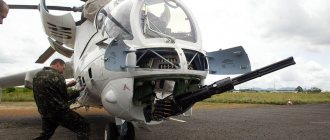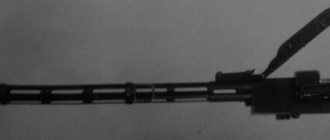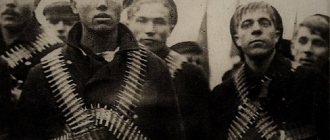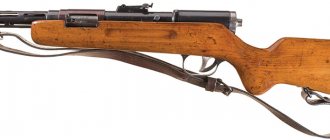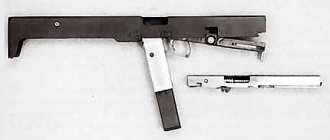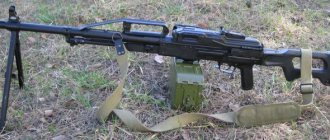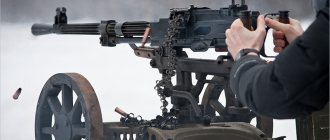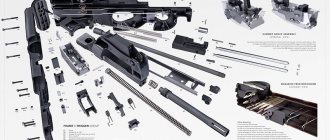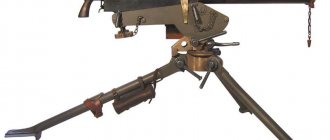| MG 13 | |
| Type: | Light machine gun |
| A country: | Germany Germany |
| Service history | |
| Years of operation: | 1930—1945 |
| Wars and conflicts: | Spanish Civil War World War II Portuguese Colonial War |
| Production history | |
| Designed by: | 1926 |
| Years of production: | 1930—1945 |
| Characteristics | |
| Weight, kg: | 13,3 |
| Length, mm: | 1340 |
| Cartridge: | 7.92×57 mm |
| Work principles: | barrel recoil, lever locking |
| Rate of fire, rounds/min: | 600 |
| Initial bullet speed, m/s: | 890 |
| Maximum range, m: | 2000 |
| Type of ammunition: | 25-round magazine or 75-round drum box |
| Images on Wikimedia Commons: | MG 13 |
MG 13MG 13 This term has other meanings, see.
MG 13
(German:
Maschinengewehr 13
) is a German light machine gun, developed on the basis of the design of the MG 08/18 light machine gun by a team of gunsmiths, technologists and engineers from the machine gun development department (
MG-Versuchsabteilung
) of Rheinmetall, headed by Louis Stange[1].
Operating countries
- Weimar Republic: adopted by the Reichswehr in 1931[1]
- Third Reich Third Reich: withdrawn from service in 1934 and replaced by the more advanced MG 34 machine gun, but continued to be used by the troops until the Wehrmacht began to receive a sufficient number of new MG 34s. In addition, the MG 13 was used to arm the first production German light tanks PzKpfw I and for arming the rear gunner on Ju 87 dive bombers. After the outbreak of World War II, warehouse stocks were transferred to the troops[1]
- Francoist Spain: after the start of the war in Spain in 1936, Germany began supplying machine guns for the Francoists[1]
- Second Spanish Republic Second Spanish Republic: during the Spanish War, a number of captured machine guns were used by the Republicans
- Portugal Portugal: Most of the retired MG 13s were sold to Portugal, where they remained in service until the late 1940s.
Application[edit | edit code]
- Arado Ar 196
- Arado Ar 196
- Blohm & Voss Ha 139
- Blohm & Voss Ha 140
- Blohm & Voss BV 141
- Blohm & Voss BV 142
- Dornier Do 17
- Dornier Do 18
- Dornier Do 23
- Dornier Do 24
- Dornier Do 215
- Dornier Do 217
- Fieseler Storch
- Focke-Wulf Fw 58
- Focke-Wulf Fw 62
- Focke-Wulf Fw 189
- Focke-Wulf Fw 200 Condor
- Gotha Go 147
- Heinkel He 46
- Heinkel He 111
- Heinkel He 114
- Heinkel He 115
- Heinkel He 119
- Henschel Hs 126
- Junkers Ju 52/3m
- Junkers Ju 86
- Junkers Ju 87
- Junkers Ju 88
- Junkers Ju 252
- Messerschmitt Bf 110
- Messerschmitt Me 321
Links
Rifles, carbines, machine guns Gewehr 1888 • Mauser 98 • Mauser 98k • Walther SK-39 • Gewehr 41 • FG-42 • MKb.42(W) • M30 Luftwaffe • SDK • Grossfuss Sturmgewehr • Gewehr 43/Karabiner 43 • HIW VSK • StG-44 • StG45 (M) • Knorr-Bremse • VK-98 • Volkssturmgewehr 1-5 • Wimmersperg Spz • Erma Volkssturmgewehr • Vollmer M-35 • Volkssturm-Mehrladegewehr Submachine guns MP-18/MP-28 • MP-34 • MP-35 • MP-36III • MP-38/40/41 • EMP-35 • MP3008 “Volks MP” Machine guns MG 08 • MG-08/15 • MG 13 • MG 34 • MG 39 Rh • MG 42 • MG 45 • VMG 1927 • Barnitzke • BSW Modell 1 • MG-81 • FWA Hobart Anti-tank weapons Grenade launchers Faustpatrone • Panzerfaust • Panzerschreck • 8.8 cm Raketenwerfer 43 “Pupchen” • Schiessbecher • Kampfpistole Anti-aircraft grenade launchers Fliegerfaust • Luftfaust-A • Luftfaust-B Mortars Granatwerfer 36 • 8-cm sGW34 • KZ 8 cm GrW 42 • 10 cm Nebelwerfer 35 • Granatwerfer 42 Flamethrowers Flammenwerfer 35 • Abwehrflammenwerfer 42 • Einstossflammenwerfer 46 Foreign weapons Rifles Vz.24/G24(t) • Gewehr 242(f) • Gewehr 306/Karabiner 561(g) • Gewehr 98(ö)/Gewehr 306/Karabiner 505(i) • Gewehr 249(a) • Winchester Model 1895 • Gewehr 301(f) • Selbstladekarabiner 455(a) • G289(j) • Gewehr 241(f) Submachine guns MP.34(ö) • MP.722(f) • MP.746(d) • MP.716(r) • MP.715(r) • MP.717(r) • MP.41(r) • MP .719(r) • MP.739(i) • MP.738(i) • MP.761(f) • MP.769 • SS-42 Machine guns MG26(t) • MG 07/12(ö) • MG30(t) • MG 099(i) • MG-126(b)/MG-147(j)/MG-156(f) • MG 157(f) • schwere MG 200(i) • MG 216(r) • 7.7mm sMG 230(e) • MG.105(f)/MG.201(n)/MG.257(f)/MG.257(p) • leicht MG 28(p) • MG35/36A Anti-tank rifles Solothurn S18-100 • Panzerbüchse 35(p) • PzB M.SS.41 Hand grenades Stielhandgranate • Eihandgranate • HL-Handgranate • Volkshandgranate • Panzerwurfmine • Nipolit • Glasgranate • Hafthohlladung Ammo 7.65x17mm • 7.63x25mm Mauser • 7.92x33mm • 7.65x21mm Parabellum • 7.92x57mm • 9x19mm Parabellum Tape Bergmann LMG 15 • CETME Ameli • Hotchkiss M1909 • Kk 62 • Vektor Mini-SS • HK MG4 • Mark 48 • Stoner 63 • RP-46 • RPD • • TKB-264 Combined Ares-16 • Daewoo K3 • M249 SAW • FN Minimi • Negev • PU-21 • Type 73
Experimental (not accepted for service) samples are in italics.
Usage
15 mm MG 151
- Bf 109 F-2. Motor gun MG 151 with impact ignition of the cartridge. Installed in the camshaft of the DB 601 engine
- Do 217E1
- Hs-129 B-1 Two MG 151 cannons with impact ignition cartridges on the sides of the fuselage, at the level of the pilot’s cabin, above the plane of the wing.
20 mm MG 151/20
- Bf 109 series: F-4, G-2, G-4, G-6: motor-gun (with impact ignition of the cartridge). It was installed in the camber of the DB 601E, N, etc. engines. The barrel passed between the camber of the engine (from the outside), firing through the propeller spinner.
- Fw 190 Synchronized guns MG 151/20 El. with electric ignition of the cartridge were installed in the root part of the wing of the Fw 190 series fighter aircraft: A-/D-/F-/G (two per vehicle) with 250 rounds of ammunition per gun. Two more guns on the vehicle were installed in the cantilever part of the wing of the Fw 190 fighter, starting from the A-6 series to the A-9 series.
- BV138, FW200, Ju188 - As part of mobile firing installations type HD151
- Nexter installs its own MG 151/20 on raider versions of Panhard VBL vehicles.[5]
Excerpt characterizing MG 13
That night Rostov was with a platoon in the flanker chain, ahead of Bagration’s detachment. His hussars were scattered in chains in pairs; he himself rode on horseback along this line of chain, trying to overcome the sleep that was irresistibly pushing him over. Behind him he could see a huge expanse of our army’s fires burning dimly in the fog; ahead of him was foggy darkness. No matter how much Rostov peered into this foggy distance, he saw nothing: sometimes it turned gray, sometimes something seemed black; then lights seemed to flash where the enemy should be; then he thought that it was only shining in his eyes. His eyes closed, and in his imagination he imagined first the sovereign, then Denisov, then Moscow memories, and again he hastily opened his eyes and close in front of him he saw the head and ears of the horse on which he was sitting, sometimes the black figures of the hussars when he was six steps away I ran into them, and in the distance there was still the same foggy darkness. "From what? It’s very possible,” Rostov thought, “that the sovereign, having met me, will give an order, like any officer: he will say: “Go, find out what’s there.” Many people told how, quite by accident, he recognized some officer and brought him closer to him. What if he brought me closer to him! Oh, how I would protect him, how I would tell him the whole truth, how I would expose his deceivers,” and Rostov, in order to vividly imagine his love and devotion to the sovereign, imagined an enemy or deceiver of the German whom he enjoyed not only killed, but hit him on the cheeks in the eyes of the sovereign. Suddenly a distant cry woke up Rostov. He shuddered and opened his eyes. "Where I am? Yes, in a chain: slogan and password – drawbar, Olmütz. What a shame that our squadron will be in reserves tomorrow... - he thought. - I’ll ask you to get involved. This may be the only opportunity to see the sovereign. Yes, it won't be long until the shift. I’ll go around again and when I return, I’ll go to the general and ask him.” He adjusted himself in the saddle and moved his horse to once again ride around his hussars. It seemed to him that it was brighter. On the left side one could see a gentle illuminated slope and the opposite, black hillock, which seemed steep, like a wall. On this hillock there was a white spot that Rostov could not understand: was it a clearing in the forest, illuminated by the moon, or the remaining snow, or white houses? It even seemed to him that something was moving along this white spot. “The snow must be a spot; spot – une tache,” thought Rostov. “That’s not good for you...” “Natasha, sister, black eyes. On... tashka (She will be surprised when I tell her how I saw the sovereign!) Natashka... take tashka...” “Straighten that, your honor, otherwise there are bushes,” said the voice of a hussar, past whom Rostov was passing, falling asleep. Rostov raised his head, which had already dropped to the horse’s mane, and stopped next to the hussar. A young child's dream irresistibly beckoned him. “Yeah, I mean, what was I thinking? - not forget. How will I speak to the sovereign? No, that’s not it – it’s tomorrow. Yes Yes! On the car, step on... stupid us - who? Gusarov. And the hussars with mustaches... This hussar with a mustache was riding along Tverskaya, I also thought about him, opposite Guryev’s very house... Old man Guryev... Eh, glorious little Denisov! Yes, all this is nonsense. The main thing now is that the sovereign is here. The way he looked at me, and I wanted to say something to him, but he didn’t dare... No, I didn’t dare. Yes, this is nothing, but the main thing is not to forget that I thought the right thing, yes. On - the car, we are - stupid, yes, yes, yes. This is good". - And he again fell with his head on the horse’s neck. Suddenly it seemed to him that they were shooting at him. "What? What? What!... Ruby! What?...” Rostov spoke, waking up. The moment he opened his eyes, Rostov heard in front of him, where the enemy was, the drawn-out cries of a thousand voices. His horses and the hussar standing next to him pricked their ears to these screams. At the place from which the screams were heard, one light came on and went out, then another, and along the entire line of French troops on the mountain, lights were lit, and the screams became more and more intensified. Rostov heard the sounds of French words, but could not make out them. There were too many voices buzzing. All you could hear was: ahhh! and rrrrr!
Ammunition
15×96 mm cartridge with H-Pzgr
intended for firing at ground targets.
High armor penetration rates of 40 mm/0°/300 m were achieved, in particular, by using a carbide core with an ogive head. 15×96 mm cartridge with Pzgr.patr caliber armor-piercing tracer (AP) projectile .
was optimized for firing at air targets.
When developing the 20-mm cartridge, Mauser designers increased the barrel diameter of the 15×96 cartridge and at the same time reduced the height of the cartridge case to 82 mm to keep the length of both cartridges the same and equal to 147 mm. The new cartridge 20x82 (sometimes designated as 20x81) was equipped with projectiles unified with those used for the MG FFM gun (fragmentation tracer, high-explosive, armor-piercing) with subsequent improvement [2]. In total, in the wartime ammunition there were seven types of 20-mm cartridges for various purposes for firing at various types of targets (nowadays, researchers call, taking into account the various types of incendiary cartridges developed, including after the war, a figure 4 times higher), which seems excessive from the point of view of practice accepted in the USSR. Cases of both calibers are brass or steel without a rim, the diameter of the base of the case is 25.2 mm.
| Cartridges for 15 mm MG 151 | Cartridge weight, g | Bullet weight, g | Charge mass, g | Explosive mass, g | Initial speed, m/s | Armor-piercing effect, mm/deg/m | Rate of fire, shots/min |
| BT 15 mm Panzergranatpatrone L'spur o. Zerl. (Pzgr. L'spur o. Zerl.) | 165 | 72 | 25,6 | — | 850 | 26/0/300 | 750 |
| BP 15 mm H-Panzergranatpatrone o. Zerl. (H-Pzgr o. Zerl.) | 151 | 52 | 26,0 | — | 1030 | 40/0/300 | 700 |
| OT with self-liquidator 15 mm Sprenggranatpatrone L'spur m. Zerl. (Sprgr. L'spur m. Zerl.) | 151 | 57 | 25,6 | 4,5 | 960 | — | 700 |
| OST with self-liquidator and day tracer 15 mm Brandgranatpatrone L'spur m. Zerl. (Brgr. L'spur m. Zerl.) | 158 | 57 | 24,5 | 1.95 + 1.4 z.sh. | 960 | — | 700 |
| OST with self-liquidator and night tracer 15 mm Brandgranatpatrone Gl'spur m. Zerl. (Brgr. Gl'spur m. Zerl.) | 158 | 57 | 24,5 | 1.95 + 1.4 z.sh. | 960 | — | 700 |
BT - armor-piercing tracer; BP - armor-piercing sub-caliber; OT - fragmentation tracer; OST - fragmentation-incendiary-tracer bullet.
| Cartridges for 2 cm MG 151/20 | Cartridge weight, g | Projectile mass, g | Charge mass, g | Explosive mass, g | Initial speed, m/s | Armor-piercing effect, mm/deg/m | Rate of fire, shots/min |
| F without self-liquidator (with self-liquidator) 2 cm M-Geschoβpatrone 151 o. Zerl. (m. Zerl.) (M.-Gesch. 151 o. Zerl. (m. Zerl.)) | 183 | 92 | 19,5 | 18.6 tenge or HA41 | 785 | 6/20/200 | 650 |
| OT (Sprgr. L'spur) | 205 | 115 | 17,8 | 6,2 | 705 | — | 700 |
| OST (Br. Sprgr. L'spur) | 205 | 115 | 17,8 | 3,7 | 705 | — | 700 |
| B (Pzgr) | 205 | 115 | 18,5 | — | 705 | 12/30/300 | 750 |
| BR (Pz. Sprgr) | 205 | 115 | 18,5 | 4,5 | 705 | 10/30/300 | 750 |
F high explosive; B armor-piercing; Armor-piercing explosive ballistic missile. Angle (degrees) from the normal to the armor surface.
The 20-mm high-explosive projectile was fundamentally new and had no analogues among the ammunition of air cannons of other warring states.
, the development of which was based on the research of ballistician Hubert Shardin (Air Force Technical Academy) of detonation processes and experimental measurements of pressure in the shock wave front. The new ammunition managed to combine a number of technical and technological innovations of that time:
- a new principle of damaging aircraft structural elements with a pressure pulse in the shock wave front (and not with fragments of the projectile body)
- a thin-walled alloy steel projectile body obtained by deep drawing, strengthened by high-frequency currents (HFC), which made it possible to increase the mass fraction of the explosive charge (filling) to 20 percent compared to 5-7 percent for fragmentation-type projectiles (OT, OST)
- a powerful explosive based on metallized PETN under the brand name Pentrit A
, which in 1942 was replaced by the
HA 41
based on hexogen, the latter characterized by increased high-explosive and incendiary effects - fuze with a delayed-action detonator on the gas-dynamic principle ( Sprengkapsel Duplex
) index
VC
. Provided the possibility of a high-explosive projectile bursting in the internal compartments of the aircraft structure, not designed for the application of excess pressure. - electric ignition of the cartridge to regulate the rate of fire, etc.
When a 20-mm high-explosive projectile hit the keel or plane of an aircraft made of wood materials (wooden or mixed construction), the aircraft instantly lost these elements, which meant the end of controlled flight.
Due to the fact that the high-explosive projectile worked effectively in the design of the aircraft, the cartridge belt configuration recommended (1944) for the 151/20 gun when firing at air targets included only 20 percent of armor-piercing rounds (2 high-explosive + 2 HP + 1 BR or BZ) [3 ]. For comparison, the standard ammunition configuration of the 20-mm Hispano-Suiza cannon of British fighters (1943-45) consisted of 50 percent armor-piercing rounds (1 OST + 1 BR)[4].
War practice has confirmed the effectiveness of a small-caliber high-explosive projectile against aircraft structures. After the war, in the USSR and allied countries (Great Britain and France), the degree of filling of aircraft shells with explosives was increased (in the USSR - doubled), which in domestic practice were called high-explosive incendiary (HEF) shells.
Notes[edit | edit code]
- ↑ 123
7.92-mm aircraft machine guns MG.15 / MG.17 // “Weapons” magazine, No. 1, 2005 (special issue “Infantry weapons of the Third Reich. Part VII. Machine guns”) pp. 46-47 - V.V. Vasiliev. “The material is of exceptional value for us and for the industry...” // Military Historical Journal, No. 6 (686), June 2020. pp. 53-58
- Kinard, Jeff.
Machine guns // The Encyclopedia of the Korean War: A Political, Social, and Military History (English) / Tucker, Spencer C.; Pierpaoli, Paul G., Jr.. - 2.ª. - ABC-CLIO, 2010. - Vol. 1. AL. - P. 535. - ISBN 978-1-85109-849-1.
